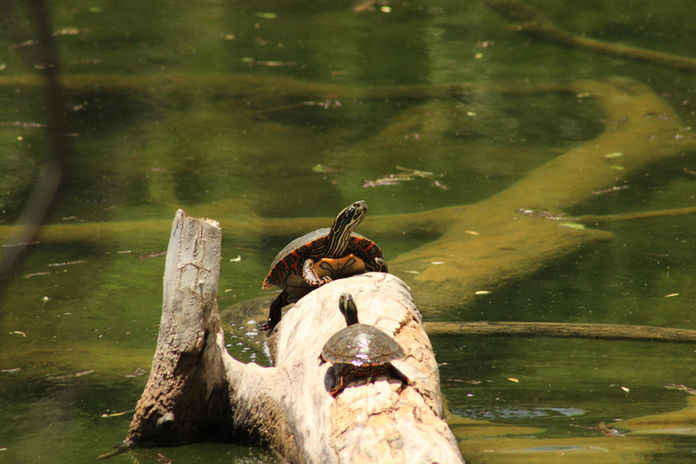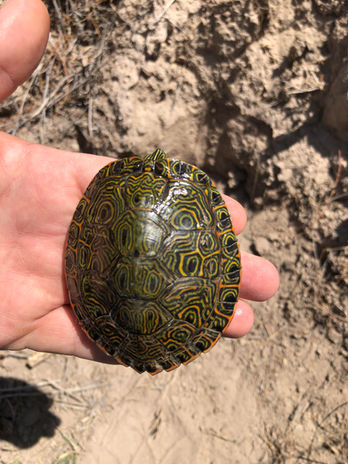
COVERED SPECIES
TEXAS HORNSHELL MUSSEL
The Texas hornshell (Popenaias popeii) is a freshwater mussel native to the Rio Grande drainage in New Mexico, Texas, and Mexico. Historically they could be found in the Pecos River system as far north as Roswell, New Mexico, down to the confluence of the Rio Grande River.The mussel's historical range also included the Rio Grande River and several tributary streams from Brewster County, Texas, downstream to as far as Brownsville, Texas. However, the mussel has been reduced to five populations within its original range, mainly through habitat degradation. The Black and Delaware rivers populations are the primary focus of the conservation agreements.
The Black River population occupies undercut riverbanks, crevices, ledges, and travertine shelves and can be found under large boulders. The preferred substrate includes small-grained materials such as clay, silt, or sand that provide areas for the mussels to anchor. They will expose only the posterior portion of the shell in areas with a soft substrate of sand or mud, allowing the animal to siphon, with the rest of their body covered with the substrate. In rocky sites, you will find it in cracks and crevices where fine sediment deposits. Filter-feeding mussels require clean, flowing water, making mussels good indicators of environmental change and aquatic ecosystem health. Both point source and non point source pollution of surface waters can affect mussel survival.
Freshwater mussels, including the Texas hornshell, have a complex life history. The life cycle of all freshwater mussels includes a larval stage or glochidia. Each glochidium must attach to an external host, most commonly a fish, although some species use salamanders. These glochidia attach to fish hosts for six weeks, transform into juvenile mussels, and then fall off the fish. Host fish aid in the dispersal of genetics and allow each individual to complete its life cycle. There is currently not much information known about the specific feeding habits of Texas hornshell. However, like all freshwater mussels, hornshell use siphons to filter feed on suspended organic material from the water column.
GRAY REDHORSE

The gray red horse (Moxostoma congestum) is a freshwater fish that historically ranged from central and west Texas and northwestern Mexico to the Pecos River and the Rio Grande in southern New Mexico and Texas.
They are grayish or brownish-yellow fish that belong to the family Catostomidae, also known as the suckers. In New Mexico, the gray redhorse historically occupied the Rio Grande downstream of Socorro and the Pecos and Black rivers from Roswell south to the Texas border. Currently, in New Mexico, the fish is only found in the Pecos and Black rivers downstream of Brantley Dam.
Gray redhorse typically occupies low gradient streams with warm, clear water. Adults can commonly be found in min medium to large pools with cobble, gravel, silt, or sand bottoms, while juveniles inhabit riffles and gravelly runs. Gray redhorse utilizes the shallow tail of pools to spawn in the spring. Gray redhorse differs from many other sucker species in that they primarily feed on insects and small mollusks; they consume relatively little vegetation. Threats to the species include range fragmentation, contamination of surface waters, modified flow regimes, and Golden Algae blooms.
It’s also important to note that the gray redhorse has been identified as one of the fourteen host fish species for the Texas hornshell mussel.
BLUE SUCKER

Photo Provided by NMDGF
The blue sucker (Cycleptus elongates), similarly to the gray redhorse, is a sucker in the family Catostomidae. It inhabits large rivers from Montana to Pennsylvania and south to the gulf coast and Mexico. The blue sucker has declined throughout much of its historic range. Although it was historically found throughout much of the Rio Grande and Pecos River drainages in New Mexico, its current range has been reduced to the Pecos River drainage downstream of Lake McMillan, including the Black River. They have been listed as endangered by the state of New Mexico and threatened by the State of Texas. Threats to the species include range fragmentation by dams, water contamination, Golden Algae blooms, and water quality changes in the Black River drainage.
Blue sucker can typically be found in deep river channels, pools with moderate currents, and deep lakes. They are a dark gray to blackish-blue in color and rarely exceed 16 inches in length in New Mexico. They are a relatively long-lived fish, as some studies show ages up to nine years old, and most females do not reach reproductive maturity until six years old.
Blue suckers typically utilize cobble and bedrock substrates in deep riffles for springtime reproductive events. Their diet is primarily made up of insect larva, algae, and other plant material. It’s also important to note that the gray redhorse has been identified as one of the fourteen host fish species for the Texas hornshell mussel.
RIO GRANDE RIVER COOTER
The Rio Grande river cooter (Pseudemys gorzugi), also known as the western river cooter in New Mexico, is a large turtle with yellow-green stripes on the head and neck and red, yellow, and black markings on the legs. The turtles average between 4 and 14 inches in length, with females being quite a bit larger than males. This species is relatively sedentary, with maximum movements of only about 300 meters. The Rio Grande river cooter can be found in large, deep pools in the Black, Delaware, and Pecos rivers in New Mexico and Texas. Currently, two of the more significant threats to the species include reductions in water quality and quantity.
PECOS SPRINGSNAIL
Springsnails are tiny mollusks with conical-shaped shells that range in color from gray to light brown. The Pecos Springsnail (Pyrgulopsis pecosensis), which has been listed as a state “threatened” species by the state of New Mexico since 1983, historically occupied only Blue Springs and Castle Springs associated with the Black River in Eddy County, New Mexico. The species has since been extirpated from Castle Springs. The Pecos Springsnail is one of nine endangered endemic springsnail species in New Mexico. Threats to the Pecos Springsnail include:
-
Water diversion
-
Drought
-
Underground pumping of water
-
Pollution from oil and gas exploration and production
-
Poor range management










